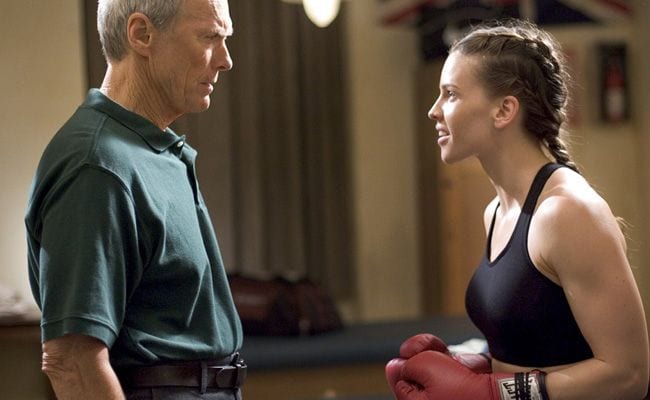
I’ve never been a big fan of the sport of boxing, but I appreciate its sociological side and how that can be mined for storytelling. For example, there’s great drama in Muhammad Ali winning a gold medal for his country at the Olympics but being turned away by restaurants in the South upon returning home. Even Sylvester Stallone’s fictional tale of a palooka getting a shot at the heavyweight champ resonates with me.
Which brings me to the Oscar-winning 2004 film Million Dollar Baby, written by Paul Haggis and produced and directed by Clint Eastwood, who plays crusty gym owner and trainer/manager Frankie Dunn. “I don’t train girls,” he growls at Maggie (Hilary Swank) when she shows up and begins working out. Like a would-be samurai refusing to take “No” from a master, Maggie keeps showing up anyway.
Finally, Frankie relents when the boxer he has been grooming for a shot at a title fight leaves him for another manager. Perhaps he’s trying to make up for the poor relationship with his estranged daughter, or maybe he wants to atone for letting a former protege, his equally crusty gym manager Scrap (Morgan Freeman), end up with an injured eye when he should have been pulled out of a fight sooner. Maggie enters the arrangement with her own share of personal issues, given her age (31, typically too old to begin formal training) and broken childhood.
As Frankie works with Maggie, she ascends the boxing ranks, knocking out her opponents early and proving her prowess. Scrap provides support, offering a counterbalance to Frankie’s curmudgeonly ways. Eventually, as in every boxing movie, our protagonist gets a shot at a title bout.
In Million Dollar Baby, however, that fight doesn’t go the way it does in most boxing film, which sets up a third act that drags on longer than it should, complete with some twisting of standard medical knowledge and practices. The controversial ending is the culmination of the quality of life themes running through the film, but it also strains the story’s credibility.
In the end, while I enjoyed the much of its setup, Million Dollar Baby feels contrived, between its reliance on boxing movie clichés and some key third act moments that ring false. Even Freeman’s narration is more on-the-nose than not — he delivers plenty of exposition that could be easily explained visually, or simply just left out. Sure, he’s Morgan Freeman of that magnificent voice, and we would listen to him read from the phone book, but sometimes less is more.
If you’re a fan who owns the earlier Blu-ray, be aware that this 10th anniversary edition ports over all the bonus features from that first release (which were in turn carried over from the earlier DVD and HD-DVD) and throws in a pair of new ones. From what I’ve read online, the video presentation is similar to the previous disc while the audio side adds a lossless soundtrack.
The new bonus features include a commentary track with producer Albert Ruddy and Million Dollar Baby: On the Ropes, a 26-minute featurette in which Ruddy, fellow producer Tom Rosenberg, Haggis, Eastwood, Swank, and Freeman talk about the struggles to get the movie off the ground. Ruddy, who bought the rights to a short story called “Million Dollar Baby” and got the project going with Haggis’ script, offers similar anecdotes in the featurette and the commentary. He tells some additional interesting stories during the commentary track, but sometimes he falls into the all-too-familiar trap of gushing over what he’s watching.
The extras ported over from the prior release include the theatrical trailer and:
• James Lipton Takes on Three: A conversation between Inside the Actor’s Studio host James Lipton and Eastwood, Freeman, and Swank. While Lipton’s style has been parodied to the point that I sometimes can’t help but snicker while watching him, he still asks many pointed questions that elicit interesting responses.
• Born to Fight: A 19-minute look at the world of boxing and how the cast members feel about the sport.
• Producers Round 15: This 13-minute piece treads some of the same territory as the On the Ropes featurette, but while the new making-of’s angle is on the film as a scrappy underdog that won the title bout, the earlier one is a more comprehensive look at the entire production.

